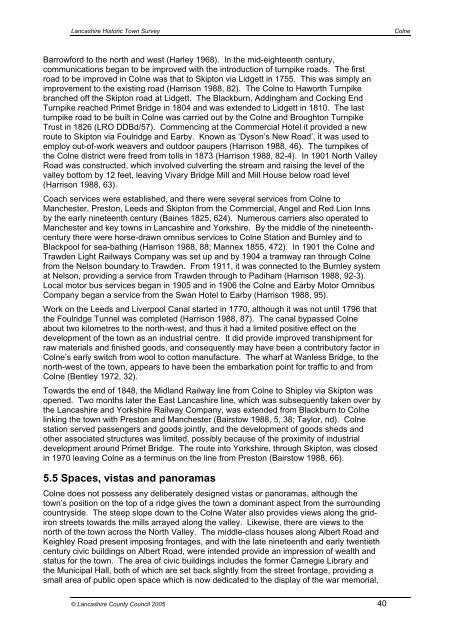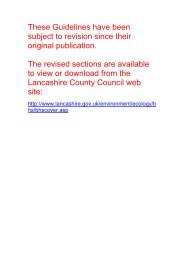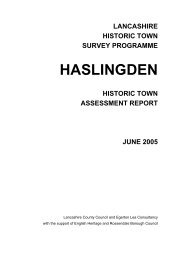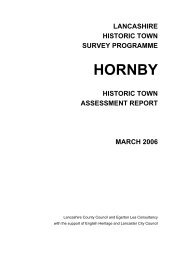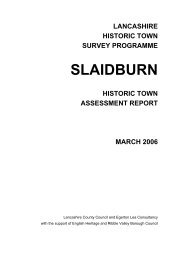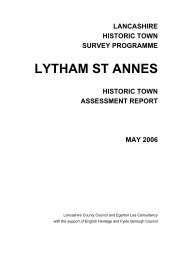Colne - Lancashire County Council
Colne - Lancashire County Council
Colne - Lancashire County Council
Create successful ePaper yourself
Turn your PDF publications into a flip-book with our unique Google optimized e-Paper software.
<strong>Lancashire</strong> Historic Town Survey<strong>Colne</strong>Barrowford to the north and west (Harley 1968). In the mid-eighteenth century,communications began to be improved with the introduction of turnpike roads. The firstroad to be improved in <strong>Colne</strong> was that to Skipton via Lidgett in 1755. This was simply animprovement to the existing road (Harrison 1988, 82). The <strong>Colne</strong> to Haworth Turnpikebranched off the Skipton road at Lidgett. The Blackburn, Addingham and Cocking EndTurnpike reached Primet Bridge in 1804 and was extended to Lidgett in 1810. The lastturnpike road to be built in <strong>Colne</strong> was carried out by the <strong>Colne</strong> and Broughton TurnpikeTrust in 1826 (LRO DDBd/57). Commencing at the Commercial Hotel it provided a newroute to Skipton via Foulridge and Earby. Known as ‘Dyson’s New Road’, it was used toemploy out-of-work weavers and outdoor paupers (Harrison 1988, 46). The turnpikes ofthe <strong>Colne</strong> district were freed from tolls in 1873 (Harrison 1988, 82-4). In 1901 North ValleyRoad was constructed, which involved culverting the stream and raising the level of thevalley bottom by 12 feet, leaving Vivary Bridge Mill and Mill House below road level(Harrison 1988, 63).Coach services were established, and there were several services from <strong>Colne</strong> toManchester, Preston, Leeds and Skipton from the Commercial, Angel and Red Lion Innsby the early nineteenth century (Baines 1825, 624). Numerous carriers also operated toManchester and key towns in <strong>Lancashire</strong> and Yorkshire. By the middle of the nineteenthcenturythere were horse-drawn omnibus services to <strong>Colne</strong> Station and Burnley and toBlackpool for sea-bathing (Harrison 1988, 88; Mannex 1855, 472). In 1901 the <strong>Colne</strong> andTrawden Light Railways Company was set up and by 1904 a tramway ran through <strong>Colne</strong>from the Nelson boundary to Trawden. From 1911, it was connected to the Burnley systemat Nelson, providing a service from Trawden through to Padiham (Harrison 1988, 92-3).Local motor bus services began in 1905 and in 1906 the <strong>Colne</strong> and Earby Motor OmnibusCompany began a service from the Swan Hotel to Earby (Harrison 1988, 95).Work on the Leeds and Liverpool Canal started in 1770, although it was not until 1796 thatthe Foulridge Tunnel was completed (Harrison 1988, 87). The canal bypassed <strong>Colne</strong>about two kilometres to the north-west, and thus it had a limited positive effect on thedevelopment of the town as an industrial centre. It did provide improved transhipment forraw materials and finished goods, and consequently may have been a contributory factor in<strong>Colne</strong>’s early switch from wool to cotton manufacture. The wharf at Wanless Bridge, to thenorth-west of the town, appears to have been the embarkation point for traffic to and from<strong>Colne</strong> (Bentley 1972, 32).Towards the end of 1848, the Midland Railway line from <strong>Colne</strong> to Shipley via Skipton wasopened. Two months later the East <strong>Lancashire</strong> line, which was subsequently taken over bythe <strong>Lancashire</strong> and Yorkshire Railway Company, was extended from Blackburn to <strong>Colne</strong>linking the town with Preston and Manchester (Bairstow 1988, 5, 38; Taylor, nd). <strong>Colne</strong>station served passengers and goods jointly, and the development of goods sheds andother associated structures was limited, possibly because of the proximity of industrialdevelopment around Primet Bridge. The route into Yorkshire, through Skipton, was closedin 1970 leaving <strong>Colne</strong> as a terminus on the line from Preston (Bairstow 1988, 66).5.5 Spaces, vistas and panoramas<strong>Colne</strong> does not possess any deliberately designed vistas or panoramas, although thetown’s position on the top of a ridge gives the town a dominant aspect from the surroundingcountryside. The steep slope down to the <strong>Colne</strong> Water also provides views along the gridironstreets towards the mills arrayed along the valley. Likewise, there are views to thenorth of the town across the North Valley. The middle-class houses along Albert Road andKeighley Road present imposing frontages, and with the late nineteenth and early twentiethcentury civic buildings on Albert Road, were intended provide an impression of wealth andstatus for the town. The area of civic buildings includes the former Carnegie Library andthe Municipal Hall, both of which are set back slightly from the street frontage, providing asmall area of public open space which is now dedicated to the display of the war memorial,© <strong>Lancashire</strong> <strong>County</strong> <strong>Council</strong> 2005 40


